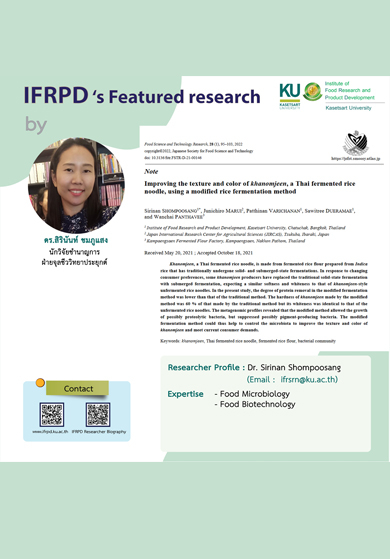| ผลงานวิจัย | ดร.สิรินันท์ ชมภูแสง และคณะ |
| Keywords | khanomjeen; Thai fermented rice noodle; fermented rice flour; bacterial community |
| Telephone | 0 2942 8629 (1408) |
| ifrsrn@ku.ac.th | |
| URL | https://doi.org/10.3136/fstr.FSTR-D-21-00146 |

Improving the texture and color of khanomjeen, a Thai fermented rice noodle, using a modified rice fermentation method

| ผลงานวิจัย | ดร.สิรินันท์ ชมภูแสง และคณะ |
| Keywords | khanomjeen; Thai fermented rice noodle; fermented rice flour; bacterial community |
| Telephone | 0 2942 8629 (1408) |
| ifrsrn@ku.ac.th | |
| URL | https://doi.org/10.3136/fstr.FSTR-D-21-00146 |
จุดเด่นผลงาน

บทสรุป : การหมักแป้งขนมจีนด้วยวิธี modified rice fermentation เป็นสภาวะที่ดัดแปลงและควบคุมกลุ่มประชากรแบคทีเรียในกระบวนการหมัก เพื่อให้ได้เส้นขนมจีนแป้งหมักที่มีความนุ่มและความขาวใกล้เคียงกับลักษณะของขนมจีนแป้งสดตามความต้องการของผู้บริโภคในปัจจุบัน แต่ยังคงความยืดหยุ่นที่เป็นเอกลักษณ์ของขนมจีนแป้งหมักไว้ได้
Abstract : Khanomjeen, a Thai fermented rice noodle, is made from fermented rice flour prepared from Indica rice that has traditionally undergone solid- and submerged-state fermentations. In response to changing consumer preferences, some khanomjeen producers have replaced the traditional solid-state fermentation with submerged fermentation, expecting a similar softness and whiteness to that of khanomjeen-style unfermented rice noodles. In the present study, the degree of protein removal in the modified fermentation method was lower than that of the traditional method. The hardness of khanomjeen made by the modified method was 60% of that made by the traditional method but its whiteness was identical to that of the unfermented rice noodles. The metagenomic profiles revealed that the modified method allowed the growth of possibly proteolytic bacteria, but suppressed possibly pigment-producing bacteria. The modified fermentation method could thus help to control the microbiota to improve the texture and color of khanomjeen and meet current consumer demands.
Food Science and Technology Research Volume 28 (1), 95–103, 2022